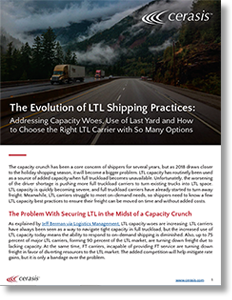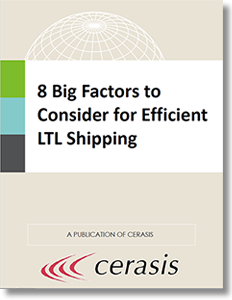Understanding Less-than-Truckload (LTL) Shipping
The shipping and transportation industry is in the midst of an evolution.
New technologies are bringing light to the furthest corners of supply chains, and shippers are struggling to find available capacity.
Full truckload carriers are starting to turn away freight in the 5001 to 10,000 weight band, and fuel surcharges are forcing prices higher.
Even LTL carriers, which typically enjoy more capacity than other types of OTR transit, are starting to feel the effects.
In turn, shippers’ freight spend is inching upward, but regional LTL carriers can help shippers keep freight spend in check.
Shippers need to understand why LTL use by shippers is increasing, the value of regional LTL carriers and how to select the right LTL carrier for their organization.
Why is LTL use Increasing?
LTL use is increasing across the board. This is in response to tightening capacity in full truckload, which ranks at an eight on a scale of 10 regarding severity.
With full truckload carriers turning away freight that might otherwise be destined for a long-haul, more shippers are turning to LTL to tap into available capacity.
At the same time, LTL carriers that have typically enjoyed lower driver turnover rates are starting to see such rates climb.
As a result, capacity is further tightening in the LTL sector. Unfortunately, this will create higher demand for LTL, and more shippers will turn to LTL before capacity runs too tight to leverage.
According to Logistics Management/Supply Chain 24/7, demand created by e-commerce will push more parcel carriers to move freight toward LTL.
Although the top 25 LTL carriers operate 90 percent of the market, shippers should not overlook the 10 percent that exists in smaller, regional LTL carriers.
What’s the Value in Regional LTL Carriers?
Heavier shipment volumes are associated with higher revenue per shipment, says William B. Cassidy of JOC.com, and as with any business, higher profitability will result in reinvestment.
This may be in the form of better pay for drivers, technology to reduce delays and additional processes that reduce overhead expenses.
As the cycle continues, overall costs for shipping freight for each shipper will decrease.
9 Tips to Choose the Right Regional LTL Carrier for Your Organization
As explained by Inbound Logistics, shippers should follow a few tips to select the right LTL transportation provider and reduce freight spend.
- Know what you’re shipping. Shippers should know how much they are shipping, its value, location, susceptibility to damage, and when it needs to arrive. Ultimately, shippers need to have better visibility into their freight, so the right LTL carrier will ensure this visibility continues after a shipment leaves the dock.
- Determine actual transit time, not published time. Most carriers publish a transit time for LTL and full truckload shipments, but these transit times may not necessarily reflect the actual transit time expected for a given carrier. Carriers that have fast-track lanes and a strong record with existing customers will make a better choice for your organization. Ask specific transit times for particular routes, and solicit feedback about the carrier’s actual transit times from other customers.
- Calculate total costs, including after-the-fact accessorial and detention fees that may be assessed. This may be a problem that some shippers can avoid, but if your organization has repeatedly incurred detention fees and accessorial charges, ask the carrier for a breakdown of such fees.
- Ask about service guarantees. With a greater focus on providing service, more carriers are offering guaranteed services, like guaranteed, next-day delivery. Shippers should look for carriers offering service guarantees.
- Don’t select the cheapest carrier. The most competitive carrier may not necessarily be the best carrier for your organization. Review multiple carriers, including those that may have higher freight rates than what you would like to pay.
- Review available capacity. The capacity crunch is worsening, and it is not unreasonable to ask a carrier about available capacity and how the company is responding to tightening capacity.
- Take advantage of technology. Shippers should also look for carriers that take advantage of technology, using automated, around-the-clock freight quoting and scheduling systems, such as a transportation management system (TMS).
- Negotiate price. A carrier’s published rate may not necessarily be the best rate they can offer you, so shippers should work to negotiate price, as well as determine the eligibility criteria for obtaining shipper for status with each carrier.
- Consider outsourcing transportation management. Another factor to consider when selecting an LTL carrier is to outsource the entire process to a third-party. For instance, a third-party logistics provider (3PL), like Cerasis, can handle the contract negotiations and use the independent, 3PL-built Cerasis Rater to ensure you get the best rates possible for your location and needs, taking advantage of regional LTL carriers as much as possible.
The Big LTL Picture
The best-laid plans for a shipping strategy rely on the ability to leverage the best carrier resources available.
As capacity becomes a greater commodity in LTL, shippers need to start working to expand their LTL carrier options and find the carriers that can move freight promptly and at the right price.
Shippers should also consider unlocking the value in regional LTL carriers by following the steps above to find and work with regional carriers that meet the proper criteria.
Related: Applying Vital Less-than-Truckload Capacity Best Practices When Freight Volume is Tight
Related LTL White Papers
Current Factors Driving the Less Than Truckload Pricing Market New!
This white paper is a must-read for shippers who are seeking information on the less than truckload pricing market in order to plan for 2019. Download Now!
The Evolution of LTL Shipping Best Practices New!
This exclusive, & educational white paper is for shippers who are accustomed to shipping LTL freight or are starting to ship more LTL freight, it addresses capacity woes, use of last-mile delivery, and how to choose the right LTL carrier. Download Now!
The State of & Pricing Outlook of the Less than Truckload Shipping Market
This is a must-read for shippers who are either LTL shipping pros, new LTL shippers who are needing education, or those moving more freight to the LTL mode as Full Truckload feels the capacity crunch squeeze. Download Now!
8 Big Factors to Consider for Efficient Less-than-Truckload Shipping
In this all-new e-book, we discuss the 8 core areas that Less-than-Truckload shippers can focus on in order to have more efficient LTL shipping practices. Download Now!
More Resources from Cerasis
Article topics
Email Sign Up























